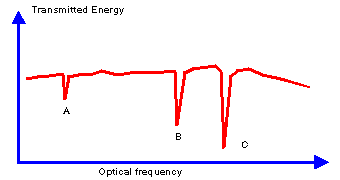Section 2.3: Principles of Lasers ó Spontaneous Emission, Stimulated Absorption and Emission
Atoms at higher energy levels tend to, or spontaneously jump to lower energy levels, in the same time they give out the electromagnetic radiation having the energy equal to the difference between the two energy levels. This is called spontaneous decay or spontaneous emission. The emission frequency is decided by:
hn = E2 - E1, E2>E1
All objects above absolute zero temperature have spontaneous emission. At thermal equilibrium, the number of atoms at different energy levels obeys the Boltzmann population distribution equation:
N2= N1 exp[-(E2-E1)/kT]
G2.6: Demo of the relation between energy difference, temperature and population inversion
Where N2 and N1 are numbers of atoms at energy state E2 and E1 repectively.
Since E2>E1, N2/N1 at thermal equilibrium will be less than one. This is the normal population distribution. If N2>N1, we say population inversion exists.
Spontaneous radiation is only one of the two forms of atomic relaxation or decay, the other is non-radiation relaxation processes like collision, thermal dissipation, etc. So the total decay time of E2 to E1 is composed of both radiative and non-radiative parts, T21=Trad,21+Tnr,21.
Stimulated transitions are essential for lasers to work. Letís analyze the following experiment. We incident broadband light on a collection of atoms, and use the grating spectrometer to measure the light passing through the medium. We will find that the detected light energy distribution with wavelength has changed from a relative smooth curve to a curve with discrete absorption lines, see the figure below.

Figure 2.7: Absorption lines
This indicates that the atoms absorb the incident energy at certain frequencies. When the atoms at lower energy levels absorb the incident energy with corresponding frequency, they jump to upper level states, this is called Stimulated Absorption. This process reduces the lower level population and increases the upper level population.
In the same time, under the action of the incident electromagnetic field with the corresponding frequency, the atoms at upper level have the same possibility to jump to the corresponding lower levels, emitting electromagnetic waves or photons with the same frequency, direction and phase with the incident waves. This process is called Stimulated Emission. Stimulated emission reduces the upper level population, increases the lower level population. Another very important thing is that it also coherently increases the incident EM wave, it transfers the pumping or incident energy into light energy! One incident photon after stimulated emission becomes two photons with same frequency, direction and phase. If this process can dominate over absorption processes, the coherent light can be amplified, i.e., becomes more and more intense with time. Then the Laseró Light Amplification by Stimulated Emission of Radiation occurs. Arenít you excited?
But under normal conditions, we could not get laser. Why? The reason is: the lower level and upper level atoms have the same chance to jump upward or downward, the upward transition absorbs the incident energy, downward transition amplifies the incident energy, so it is the population difference between the two levels that decides whether there can exist a net amplification of the incident energy. At thermal equilibrium of normal conditions, the upper level atom population is always less than the lower level atom population, so the stimulating radiation can only attenuate when it interacts with the medium. We must first make the upper level population larger than the lower level to generate laser light, i.e., we must create Population Inversion first.